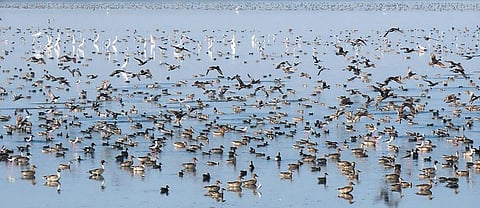

During spring two years ago, India was under lockdown. In order to relieve the tedium of staying indoors, people started looking outdoors. Sunset, sunrise and moon photography started dominating social media posts. So did wildlife—the kind that lives among us. Across the world, observations of birds increased, as people turned into balcony birders.
With fewer people on the roads, wildlife was freer to forage for food or go about business. Equally, the life cycles of wild animals continued as they always have. In March, yellow-footed green pigeons broke off twigs from siris trees to make nests. Bats would visit a false ashok tree to feast on its purpling fruit after the monsoon.
A brahminy starling family, noisy and chattering, raised their young in a nest box on my balcony. Occasionally, a black kite would come and sit on the terrace, after its long, soaring flights in air thermals. For the first time, I noticed the weary city sky full of post-monsoon rainbows.
Social media had a lot of questions—which call belonged to which bird? A message on a residential WhatsApp group reported an amazing ‘dinosaur’ spotted in the colony (the animal turned out to be a harmless monitor lizard). Long-gone animals were claimed to be seen. In a viral clip, someone declared they had seen the possibly extinct Malabar civet crossing the road (it was possibly a small Indian civet using a zebra crossing).
In London, researchers from King’s College London and Bristol University noticed a shift in the dietary patterns of peregrine falcons. Normally, these hunters ate pigeons. With fewer people, less garbage, and fewer racing pigeons released on the streets and the skies, there were lesser pigeons to eat. So, the falcons hunted more parakeets and starlings.
The pandemic led to incalculable tragedies, and we continue to feel the threat of isolation and loss of family members. It also led to newer ways of living. Offices continue to function through remote or hybrid modes of work to cut down on the emotional, financial and carbon costs of a daily commute. At least some of us have consciously chosen not to work ourselves to death, and to prioritise health and family.
The lesser-talked-about aspect is that of a fellow feeling for nature. Many lockdown balcony birders have continued their passions. And this provides hope for a truly progressive way of living—in which we understand that we are a part of nature, not removed from it, or owning it.
At the core of it, balcony birdwatching is about paying attention to something as intimate as a tree, a bird and a flower. The person who notices a single tree may also become part of movements to save trees, such as the current citizen action to save the grand banyan trees of Chevella on the Hyderabad-Bijapur highway.
While this generation is feeling the impacts of climate change, it is hopefully also a generation that has learned to stay present in its immediate environs. For it is in the intimate that the grand plays out too: an innocuous flower you notice today on a lamppost may remain a lifelong flag post for you.
Neha Sinha
Conservation biologist and author
Twitter: @nehaa_sinha